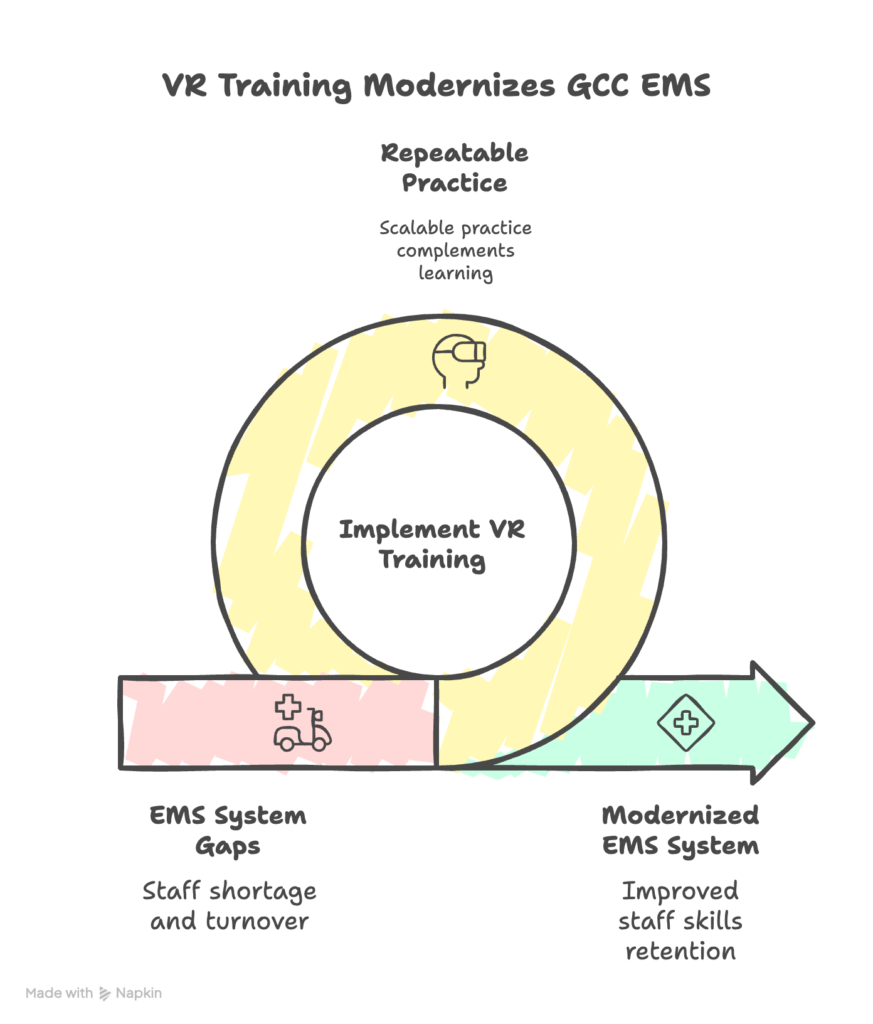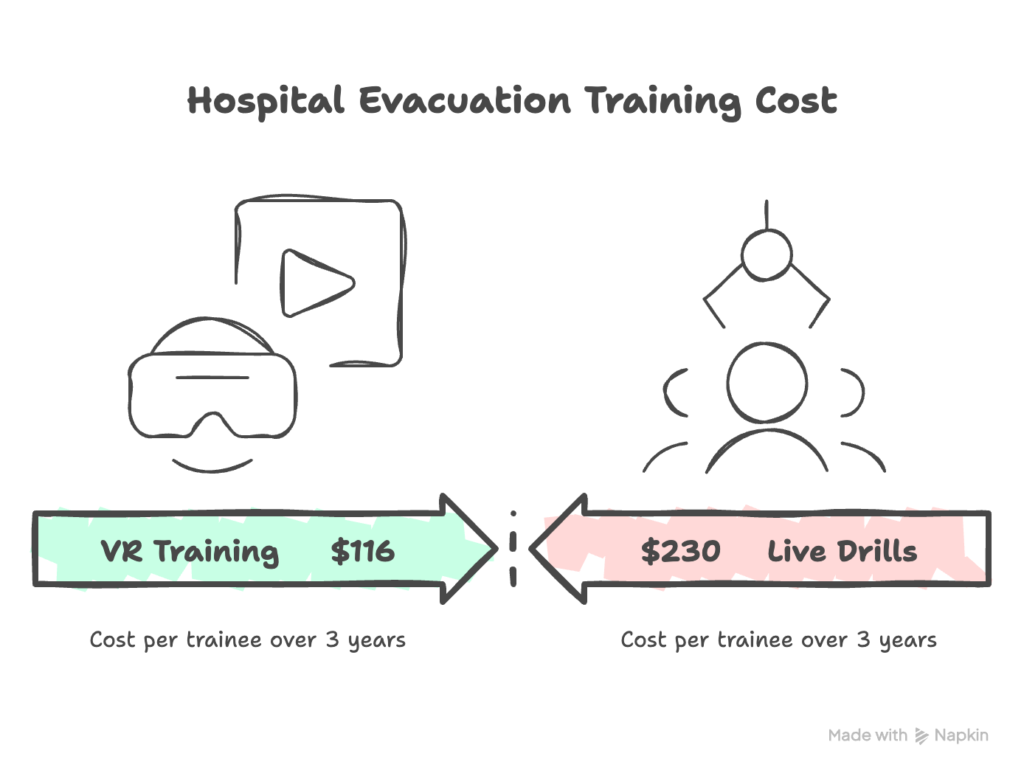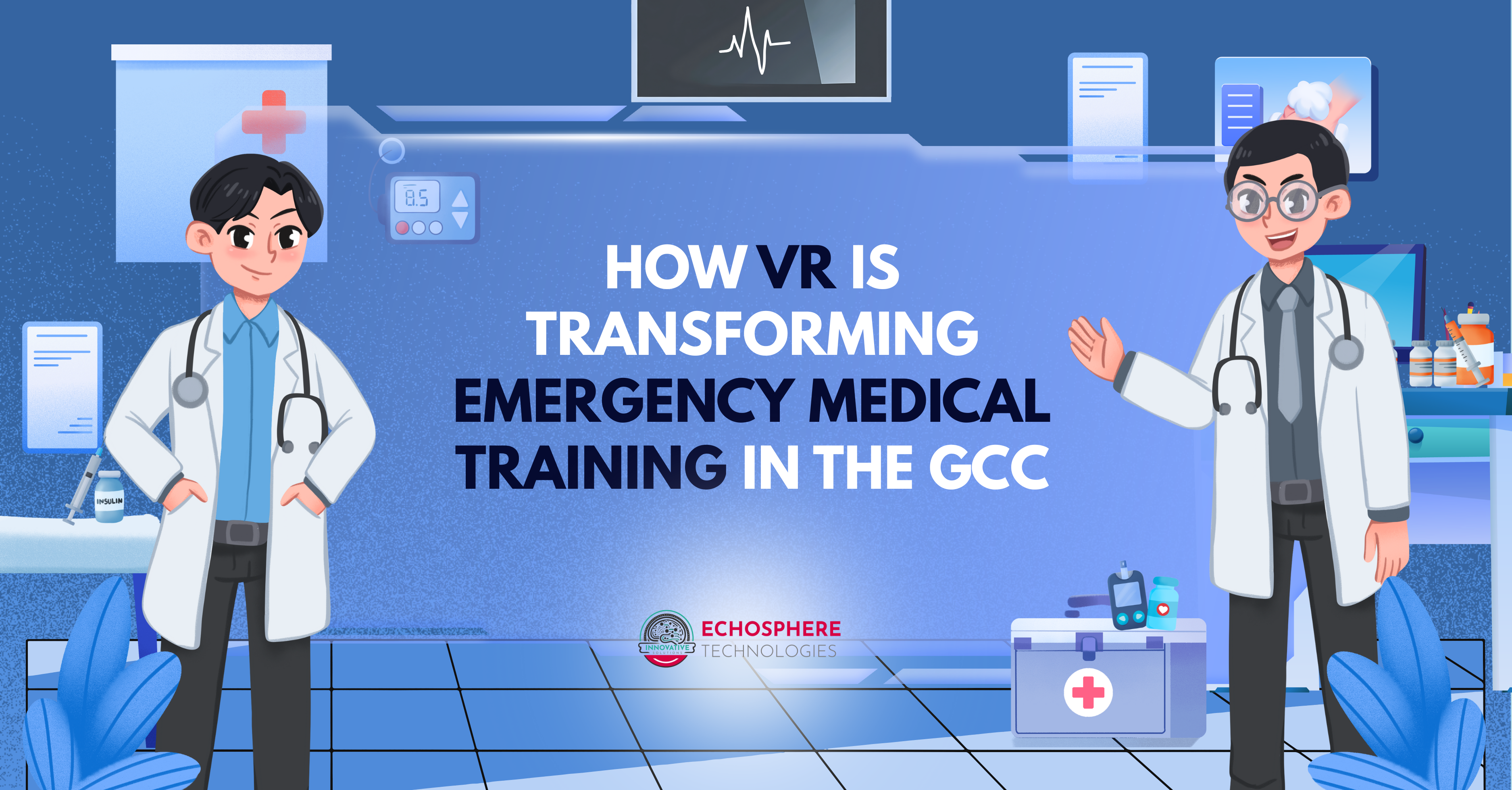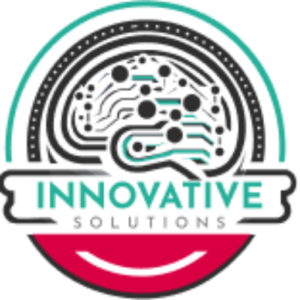Emergency medical training is undergoing a dramatic shift in the Gulf Cooperation Council (GCC), driven by immersive virtual reality (VR) and gamification. As GCC health systems expand under ambitious national visions, decision-makers face urgent challenges: rapidly upskilling a growing workforce, improving readiness for mass-casualty incidents, and modernizing EMS education – all while containing costs. Traditional drills and mannequin labs are valuable, but they require extensive space, staff and equipment. VR-based scenarios, by contrast, let trainees enter realistic, high-stress emergencies virtually, repeatedly and safely. Numerous studies now show that VR simulations engage learners, boost skill retention, and prepare responders for life‑saving tasks more effectively than lectures or one-off exercises[1][2]. In the GCC’s high-growth, tech-savvy context, immersive training is proving its worth. This article explores how VR and game-design elements are revolutionizing paramedic and EMS education in the Gulf – improving performance and preparedness in line with regional digital-health goals – and how stakeholders can leverage these tools for safer, smarter healthcare.
EMS Training Needs and Opportunities in the GCC
GCC countries are investing heavily in health and emergency services, but they face headwinds that VR training can address. Populations are growing and aging, raising demand for emergency care. Saudi Arabia, for example, plans to add 17,000–34,000 new hospital beds by 2030 and has allocated roughly $50 billion to health and social development initiatives[3]. At the same time, workforce projections show major gaps: Saudi’s Health Sector Transformation Program aims to recruit 175,000 new healthcare professionals by 2030 (doctors, nurses, allied health), reflecting a current reliance on expatriate staff and the challenge of “creating a sustainable workforce”[4]. Similarly, the UAE’s National Ambulance has partnered with local colleges to train Emirati paramedics, underscoring a regional priority on “boosting national talent” in EMS[5][6].
These efforts sit alongside a wave of digital-health strategies. Saudi Arabia’s Vision 2030 explicitly calls for a unified electronic health record and AI-driven healthcare[7][8]. The UAE has made digital transformation a priority through its Digital Government Strategy and AI initiatives[9]. Smart hospital projects and genome/digital‑twin programs in Bahrain, Kuwait and Qatar further signal a GCC-wide enthusiasm for new tech[10][11]. In this environment, EMS modernization is a natural target. A 2022 comparison of GCC EMS systems reported common “shortage and turnover of staff”, plus gaps in ambulances and funding[12][13]. Skills decay is also a concern: high-stakes scenarios like multi-vehicle accidents or disaster response occur rarely, so memory fades between drills. Immersive VR and gamified simulations can help overcome these gaps by allowing repeatable, scalable practice that complements on-the-job learning[2][14].

VR and Gamification: A New Frontier in Training
VR places trainees inside a 360° emergency, while gamification adds game-like feedback (points, levels, leaderboards). Unlike passive study, VR makes EMS providers active participants. They can run code blues in a virtual hospital, triage a simulated traffic pileup, or treat a victim in a burning building – all with high realism and instant feedback. For example, ParaVR and other simulators recreate triage and life-support tasks in first-responder scenarios[15][16]. Importantly, these systems record performance – correct actions, response times, errors – and often award “scores” or badges for proficiency. This gamified element has proven motivational: in one open-access study of a VR surgical system, researchers found that adding game design elements significantly improved trainees’ outcomes and motivation[17]. In EMS training specifically, gamification can reward quick, correct decisions (e.g. radio reports, patient stabilization) just as in a game, making learning engaging and memorable[17][18].
The advantages are clear. VR-based training is risk-free and immersive, so novices can make mistakes without harming real patients[2][15]. It’s also repeatable on-demand – agencies can deploy one VR station to train dozens of staff on their own schedules, rather than coordinating large live drills. Over time, this means mastery: “VR offers a cost-effective, scalable alternative to traditional training methods,” authors note, as scenarios can be practiced until skills solidify[2][14]. And because simulations are standardized, every trainee sees the same high-quality scenario (for example, a standardized cardiac arrest sequence), reducing variability in learning. In short, VR gamifies training so that learning is active, measurable, and fun – a leap forward from textbooks or isolated mannequin labs.
Evidence of Impact: Engagement, Retention and Response
A growing literature confirms that VR and gamified EMS training work. A recent systematic review in Frontiers in Disaster Medicine analyzed 19 studies of virtual/augmented reality in EMS training. It concluded that immersive tech “demonstrated significant potential to enhance EMS training by improving skill acquisition and readiness” for mass-casualty and other high-stakes events[19]. Notably, the review highlighted “enhanced engagement, accessibility, cost-efficiency [and] standardization” as key benefits of VR training[1]. In other words, learners stay more focused and motivated, learning can reach more people, and budgets stretch further.
Individual studies reinforce these findings. In an Israeli trial of VR versus traditional drills for mass-casualty triage, paramedic students training in VR reported significantly lower mental demand and frustration (measured by NASA-TLX) than those in mannequin-based exercises[20]. The VR group also made more accurate situational reports (e.g. reading METHANE). Both groups performed similarly on triage accuracy, but VR trainees were faster at some tasks and took more time initially to navigate the novel interface. Overall researchers found VR “a promising tool” for preparing responders by simulating realistic, high-pressure scenarios in a controlled setting[21][22].
Importantly, trainees retain what they learn. In our simulation-lab example from Abu Dhabi (below), students repeatedly practiced critical procedures (like intubation and hemorrhage control) in VR before testing. This repetition drives long-term retention: as one VR training review notes, “EMS clinicians can refine their skills, acquire new knowledge, improve retention, and ultimately be better prepared for the increasingly technologically advanced workplace”[2]. Elsewhere, VR has been shown to boost knowledge scores in emergency drills by double-digit percentage points compared to web-based learning[23]. And because VR can realistically simulate environmental stressors (alarms, crowds, chaos), it also conditions trainees’ decision-making under pressure.
Finally, VR training can accelerate organizational readiness and cut costs over time. A 2020 cost-analysis of hospital evacuation training found that, after initial development, VR scenarios cost roughly $116 per trainee (averaged over 3 years), versus $230 per trainee for live drills[14]. At scale, the savings compound: live exercises require taking staff off-duty and even using patient beds, whereas a VR kiosk can train dozens of people with minimal disruption[24][25]. In sum, VR gamification not only deepens learning but also makes frequent, agency-wide training affordable and logistically feasible[24].
Regional Initiatives Supporting VR and Digital EMS
The GCC’s tech-forward policies are creating a strong foundation for VR adoption in healthcare. Saudi Vision 2030 explicitly fosters an “e-Health Initiative” to build a unified digital infrastructure in hospitals[7]. In 2023 Saudi allocated over SAR 214 billion (about $57 billion) to health and social development, including hospital expansion and what one report calls “ambulance connectivity automation”[3]. The Saudi Data & AI Authority has since driven AI in medicine, and telemedicine projects are proliferating. In the UAE, national strategies emphasize digital government and innovation: for instance, Dubai’s “Digital Government Strategy 2025” targets smart healthcare services, and the UAE has even appointed a dedicated AI minister to lead tech in healthcare[9]. These policies align well with VR-based training, which can be framed as a natural extension of the digital health ecosystem.
Several GCC institutions are already rolling out VR training. In Abu Dhabi, the Fatima College of Health Sciences (FCHS) established a Paramedic Virtual Simulation Lab that has attracted UNESCO-UNEVOC recognition[26]. This lab immerses students in emergency scenarios so they can practice life-support, trauma care and disaster response virtually. To date 336 students have trained on advanced procedures using this system[27]. As the Abu Dhabi media office reports, the VR lab “enhances the clinical skills and decision-making abilities of paramedic students through simulated emergency scenarios,” providing hands-on practice and instant feedback to prepare them for real-world crises[27]. The result: students gain competence and confidence more rapidly, leading to higher-quality patient care when they graduate[28].

Meanwhile in academia, Dubai’s Higher Colleges of Technology has partnered with the National Ambulance to boost EMS training for UAE citizens[5][6]. Though not VR-based, this underscores the emphasis on improving and localizing EMS education. In private practice, Gulf hospitals are also eager: Emirates Health Services (DHA) and others have used VR for nurse/doctor training and rehab, sending a clear message that immersive tech is welcome in Gulf healthcare. Taken together, these government and institutional moves mean that VR and gamification are not foreign concepts in the GCC – they fit squarely within the region’s “digital transformation” agenda[7][8].
Benefits of Gamified VR Training
- Immersive Learning: Trainees “learn by doing” in a virtual field hospital or crash site, rather than by rote. Controlled experiments show that this active participation leads to higher engagement and better information recall[1][18].
- Safe, Repeatable Practice: VR removes the risks of live drills. A rookie can intubate virtual patients or triage virtual casualties without fear, and then immediately repeat the scenario to correct mistakes. As one review notes, VR training eliminates “adverse effects on patients and minimizing direct risks to participants”[2].
- Consistent, Standardized Scenarios: Every trainee faces the same evidence-based scenario (for instance, a textbook-grade myocardial infarction response). This consistency ensures uniform competency benchmarks across agencies, unlike ad-hoc field training which can vary by instructor.
- Cost-Efficiency and Scalability: Once a VR scenario is developed, it can be deployed to any number of headsets or centers. Compared to expensive ambulances and manikins, VR equipment and software scale to large cohorts cheaply[2][14]. Over time and multiple cohorts, VR can halve per-trainee costs versus live drills[14].
- Data-Driven Feedback: Gamified systems automatically log each learner’s actions. Trainers can review performance analytics (reaction time, decision accuracy) and even award virtual badges or certificates. This instant feedback loop accelerates mastery and allows tracking progress objectively over time.
Collectively, these benefits create a “multiplier effect” in high-growth healthcare systems. A single VR suite can train dozens of paramedics per week, preserving scarce instructor time. It also makes retraining easier – an important factor given how clinical guidelines evolve. As one systematic review concludes, VR and related XR tools offer “a cost-effective, scalable alternative to traditional training” that keeps EMS skills sharp[2].
Overcoming Adoption Challenges
Despite clear upside, some barriers exist in the Gulf context. Initial investment in VR headsets and scenario development can be high, which gives procurement teams pause. However, costs have been falling: consumer VR kits and cloud-based simulation software mean that even medium hospitals can now pilot VR for a few thousand dollars. Importantly, evidence shows that these upfront costs rapidly pay off as training is repeated[24]. Decision-makers should view VR not as an expense but as a long‑term saving: one cost-analysis noted that a year’s worth of drills could be conducted in VR “at roughly half the cost per trainee” of live exercises[14].
Cultural fit can also be a concern. Some older clinicians worry that games are “frivolous” or that screen time cannot replace human instruction. To counter this, institutions in the region are gradually blending VR with traditional methods. For example, UAE paramedics might complete VR scenarios as homework between instructor-led skills labs. This hybrid approach ensures technology supplements rather than supplants mentorship. Moreover, gamification elements (scores, competition) can be tuned to local norms; in fact, younger Gulf trainees often welcome tech in education. EchoSphere’s local customers report strong buy-in once staff see the realistic simulations.
Regulation is another factor. For VR training to count towards official certifications, health authorities must recognize and accredit these hours. The good news is that Gulf regulators are increasingly flexible: Saudi and UAE licensing bodies have already endorsed simulation-based credits for continuing education. In fact, Saudi’s e-Health and training authorities encourage innovation under Vision 2030, even funding pilot programs. By partnering early with regulators, training institutions can ensure VR curricula meet local standards (for instance, aligning a cardiac arrest VR module with the Saudi CPR guidelines).
In short, challenges like cost or conservatism can be overcome with pilot projects and evidence. Once key stakeholders witness how VR boosts confidence and fills training gaps, as in Abu Dhabi and elsewhere, the momentum carries forward. Indeed, the COVID-19 pandemic underscored the need for remote-friendly training: UAE leaders cited the crisis as proof that healthcare is “the first line of defense”[29] – and that modern tools (including VR) are needed to keep that line strong.

Looking Ahead: VR-Ready GCC EMS
The Gulf’s commitment to digital health makes it an ideal testbed for VR and gamified training. With governments pouring billions into smart hospitals, AI and health IT[8][3], the infrastructure and enthusiasm are already in place. VR labs like the one at FCHS show how GCC institutions can blend their tech goals with workforce development: trainees there now graduate with VR-enhanced skillsets and familiarity with cutting-edge tools[28][22]. Companies like EchoSphere Technologies – based in the region – are ready to support this shift with turnkey VR solutions.
As one recent review put it, immersive VR “eliminates the logistical and financial challenges” of traditional drills[2]. For a rapidly growing healthcare sector, that means being able to train more people, more frequently, without blowing the budget. And because VR fosters confidence and “muscle memory” for rare events, it directly improves patient outcomes. By integrating realistic game-like training into EMS curricula, Gulf health systems can ensure the next generation of paramedics and first responders are truly battle-tested – at least virtually – before they face real crises.
Call to Action: The time is now for GCC health ministries, hospitals and academies to explore VR-based training. EchoSphere Technologies invites you to discover its VR paramedic platform: an immersive, gamified training system aligned with GCC goals. Our solutions offer repeatable emergency scenarios, real-time performance feedback, and proven engagement metrics – all fully configurable to your protocols. Contact EchoSphere to pilot a VR training lab, and empower your EMS staff to train faster, safer, and smarter. Together, we can transform emergency care in the Gulf through cutting-edge education.
[1] [2] [19] Frontiers | Extended reality technology for emergency medical service training: systematic review
[3] [4] How Saudi’s Vision 2030 is going to Transform the Healthcare Industry
[5] [6] [29] HCT Partners with National Ambulance to Train and Recruit Emirati Emergency Medical Technicians – Higher Colleges of Technology
[7] National E- Health Strategy – E-Health Initiative in Digital Transformation (Vision 2030)
https://www.moh.gov.sa/en/Ministry/nehs/Pages/vision2030.aspx
[8] [9] [10] [11] How digital innovation is reshaping Middle East healthcare | World Economic Forum
https://www.weforum.org/stories/2024/10/digital-innovation-reshaping-healthcare-middle-east/
[12] [13] A Comparison of Three Emergency Medical Services Organizations in the Gulf Council Cooperation Countries
[14] [23] [24] [25] Comparative Cost of Virtual Reality Training and Live Exercises for Training Hospital Workers for Evacuation – PMC
https://pmc.ncbi.nlm.nih.gov/articles/PMC7231540/
[15] [16] [18] VR in Paramedic Training: Enhancing Emergency Skills – Ricky Rescue Training Academy
https://emsricky.com/virtual-reality-in-paramedic-training/
[17] Medical training in virtual reality: a gamification approach | Virtual Reality
https://link.springer.com/article/10.1007/s10055-025-01159-4
[20] [21] [22] Exploring the role of virtual reality in preparing emergency responders for mass casualty incidents | Israel Journal of Health Policy Research | Full Text
https://ijhpr.biomedcentral.com/articles/10.1186/s13584-025-00681-9
[26] [27] [28] Abu Dhabi Centre for Technical and Vocational Education and Training’s Paramedic Virtual Simulation Lab acknowledged by UNESCO-UNEVOC







